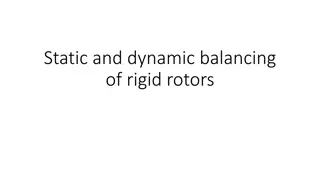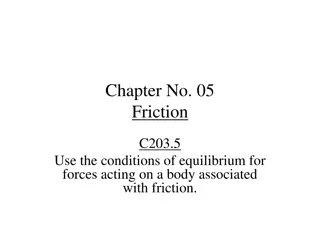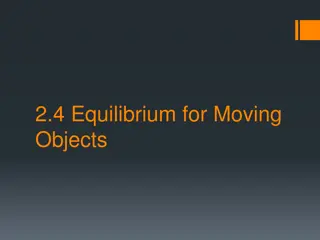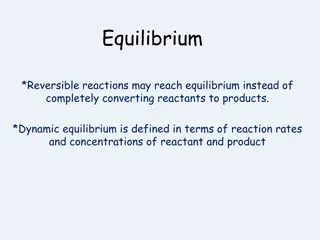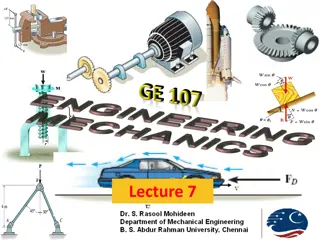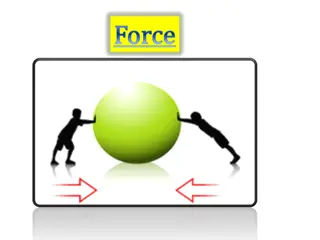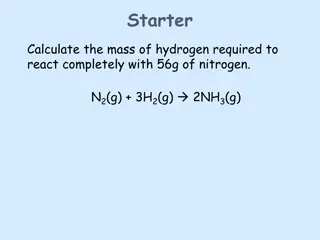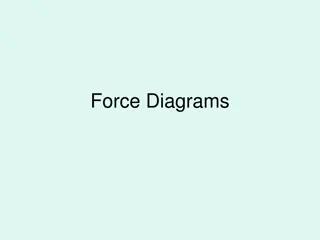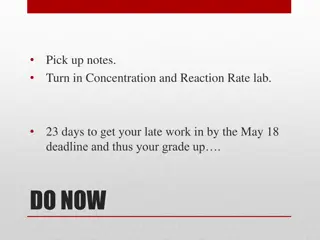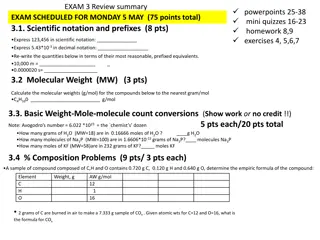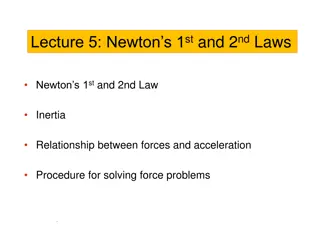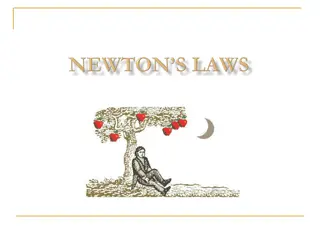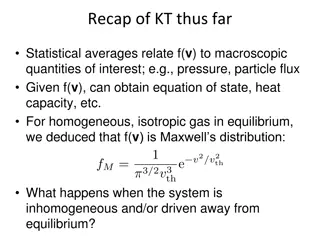Applications of Forces in Limiting Equilibrium for Solving Rigid Body Problems
Explore the principles of limiting equilibrium in rigid bodies with practical examples involving forces and friction. Learn how to analyze and solve problems, such as determining reaction forces and coefficients of friction, to ensure stability and balance in mechanical systems.
Download Presentation

Please find below an Image/Link to download the presentation.
The content on the website is provided AS IS for your information and personal use only. It may not be sold, licensed, or shared on other websites without obtaining consent from the author.If you encounter any issues during the download, it is possible that the publisher has removed the file from their server.
You are allowed to download the files provided on this website for personal or commercial use, subject to the condition that they are used lawfully. All files are the property of their respective owners.
The content on the website is provided AS IS for your information and personal use only. It may not be sold, licensed, or shared on other websites without obtaining consent from the author.
E N D
Presentation Transcript
Applications of Forces N B 2m You can solve problems about rigid bodies resting in limiting equilibrium (2) 3m (1) R 5m 40gCos15 If a body is on the point of moving it is said to be in limiting equilibrium. In this case, the frictional force takes its maximum value, R, where is the coefficient of friction and R is the normal reaction. 40g 15 40gSin15 A F Draw a diagram and label all the forces: Weight, the normal reactions and friction. Split into components if needed The rod will have a tendency to slide downwards, with the base moving to the left. Hence, friction will oppose this Taking moments about A will mean we can find the normal reaction at the peg. Taking moments about A (1) (2) ? 8 = 8? ?? ????????????? A uniform rod AB of mass 40kg and length 10m rests with the end A on rough horizontal ground. The rod rests against a smooth peg C where AC = 8m. The rod is in limiting equilibrium at an angle of 15 to the horizontal. Find: 40????15 5 = 200????15 ?? ????????? 40gSin15 is NOT included as a moment about A. This is because it actually acts down the rod and through point A (as opposed to the place where it has been drawn), therefore it has a perpendicular distance of 0 and hence can be ignored 200????15 = 8? a) The magnitude of the reaction at C ? = 237? Divide by 8 25????15 = ? Calculate b) The coefficient of friction between the rod and the ground 237 = ? 7D
Applications of Forces 237Sin15 B You can solve problems about rigid bodies resting in limiting equilibrium 237 R 40gCos15 If a body is on the point of moving it is said to be in limiting equilibrium. In this case, the frictional force takes its maximum value, R, where is the coefficient of friction and R is the normal reaction. 40g 15 40gSin15 A F Now you can resolve horizontally and vertically to find the remaining forces You will need to split the normal reaction at the peg into horizontal and vertical components The parallel and perpendicular components of the weight will no longer be needed A uniform rod AB of mass 40kg and length 10m rests with the end A on rough horizontal ground. The rod rests against a smooth peg C where AC = 8m. The rod is in limiting equilibrium at an angle of 15 to the horizontal. Find: Resolving Horizontally ?( ) ? = 237???15 Resolving Vertically ?( ) a) The magnitude of the reaction at C ? = 237? ? + 237???15 = 40? Rearrange b) The coefficient of friction between the rod and the ground ? = 237???15 ? = 40? 237???15 ? = 40? 237???15 7D
Applications of Forces 237Sin15 B You can solve problems about rigid bodies resting in limiting equilibrium 237 R If a body is on the point of moving it is said to be in limiting equilibrium. In this case, the frictional force takes its maximum value, R, where is the coefficient of friction and R is the normal reaction. 40g 15 A F As the rod is in limiting equilibrium, friction is at its maximum value Use the formula for FMAX and sub in the values we have calculated A uniform rod AB of mass 40kg and length 10m rests with the end A on rough horizontal ground. The rod rests against a smooth peg C where AC = 8m. The rod is in limiting equilibrium at an angle of 15 to the horizontal. Find: ????= ?? Sub in values 237???15 = ?(40? 237???15) Divide by the bracket 237???15 40? 237???15= ? Calculate a) The magnitude of the reaction at C ? = 237? 0.37 = ? b) The coefficient of friction between the rod and the ground ? = 237???15 ? = 40? 237???15 7D
Applications of Forces You can solve problems about rigid bodies resting in limiting equilibrium 60 RW B (3) Start with a diagram and label all forces both masses should be split into parallel and perpendicular components 1.5a A ladder, AB, of mass m and length 3a, has one end A resting on rough horizontal ground. The other end, B, rests against a smooth vertical wall. A load of mass 2m is fixed on the ladder at point C, where AC = a. The ladder is modelled as a uniform rod and the load is modelled as a particle. The ladder rests in limiting equilibrium at an angle of 60 with the ground. (2) 0.5a (1) 60 RG We will now take moments about point A to give us the value of RW C a 60 60 F mg 2mg A (1) 2?????60 ? = 2??????60 ?? ????????? (2) ?????60 1.5? = 1.5??????60 ?? ????????? Find the coefficient of friction between the ladder and the ground. (3) ?????60 3? = 3??????60 ?? ????????????? ??=3.5?????60 3???60 3??????60 = 2??????60 + 1.5??????60 Cancel a s 3?????60 = 2?????60 + 1.5?????60 Calculate in terms of mg Group terms ??=7?? 3 3?????60 = 3.5?????60 ??=3.5?????60 Divide by 3Sin60 18 7D 3???60
Applications of Forces You can solve problems about rigid bodies resting in limiting equilibrium 60 RW B (3) Now we can resolve horizontally and vertically 1.5a A ladder, AB, of mass m and length 3a, has one end A resting on rough horizontal ground. The other end, B, rests against a smooth vertical wall. A load of mass 2m is fixed on the ladder at point C, where AC = a. The ladder is modelled as a uniform rod and the load is modelled as a particle. The ladder rests in limiting equilibrium at an angle of 60 with the ground. (2) 0.5a This will allow us to find expressions for RG and F, and hence, the coefficient of friction (1) 60 RG C a 60 60 F mg 2mg A Resolving Horizontally ?( ) ? = ?? We already know RW so therefore also know F! Find the coefficient of friction between the ladder and the ground. ? =7?? 3 18 ??=7?? 3 ? =7?? 3 18 18 7D
Applications of Forces You can solve problems about rigid bodies resting in limiting equilibrium 60 RW B (3) Now we can resolve horizontally and vertically 1.5a A ladder, AB, of mass m and length 3a, has one end A resting on rough horizontal ground. The other end, B, rests against a smooth vertical wall. A load of mass 2m is fixed on the ladder at point C, where AC = a. The ladder is modelled as a uniform rod and the load is modelled as a particle. The ladder rests in limiting equilibrium at an angle of 60 with the ground. (2) 0.5a This will allow us to find expressions for RG and F, and hence, the coefficient of friction (1) 60 RG C a 60 60 F mg 2mg A Resolving Vertically ?( ) ??= 2?? + ?? Simplify Find the coefficient of friction between the ladder and the ground. ??= 3?? ??=7?? 3 ? =7?? 3 18 18 ??= 3?? 7D
Applications of Forces You can solve problems about rigid bodies resting in limiting equilibrium 60 RW B (3) 1.5a A ladder, AB, of mass m and length 3a, has one end A resting on rough horizontal ground. The other end, B, rests against a smooth vertical wall. A load of mass 2m is fixed on the ladder at point C, where AC = a. The ladder is modelled as a uniform rod and the load is modelled as a particle. The ladder rests in limiting equilibrium at an angle of 60 with the ground. As the ladder is in limiting equilibrium, we can use the formula for friction (2) 0.5a (1) 60 RG C a 60 60 F mg 2mg A ????= ?? Sub in values 7?? 3 18 Find the coefficient of friction between the ladder and the ground. = 3??? Cancel mg s 7 3 18 = 3? ??=7?? 3 ? =7?? 3 Divide by 3 18 18 7 3 54 = ? ??= 3?? Calculate 0.22 = ? 7D



